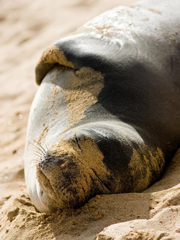|
HAWAIIAN MONK SEAL } Monachus schauinslandi

|
RANGE: Throughout the northwestern Hawaiian islands, with an increasing population on the main islands
STATUS: This seal is listed as Endangered under the U.S. Endangered Species Act.
THREATS: Food scarcity due to factors such as overfishing, competition for prey, and changes in oceanographic and climatic conditions; entanglement in marine debris; global warming; shark predation; interactions with fisheries; habitat loss and disturbance; and disease
Named for its resemblance to a Catholic monk, the Hawaiian monk seal has folds around its neck and is gray in color, with pelage often turning brown from weathering. This federally endangered seal has seen dramatic population declines in the last half-century that have left it one of the world’s most imperiled marine mammals — and thanks to global warming, which interferes with delicate marine ecosystems and causes sea-level rise that endangers seal pupping beaches, the seal has become more vulnerable than ever in recent years. Fortunately, even as its numbers tumble downward in its core range on the northwestern Hawaiian islands, seals are increasingly inhabiting the main Hawaiian islands, where pups are healthy and the population is on the rise. Due to a Center for Biological Diversity petition, the Obama administration announced it would grant the seal protected habitat on the main islands, in addition to expanding protections in the northwestern islands. The Center has also defended the monk seal from fisheries that depleted the seal’s precious food sources.
|